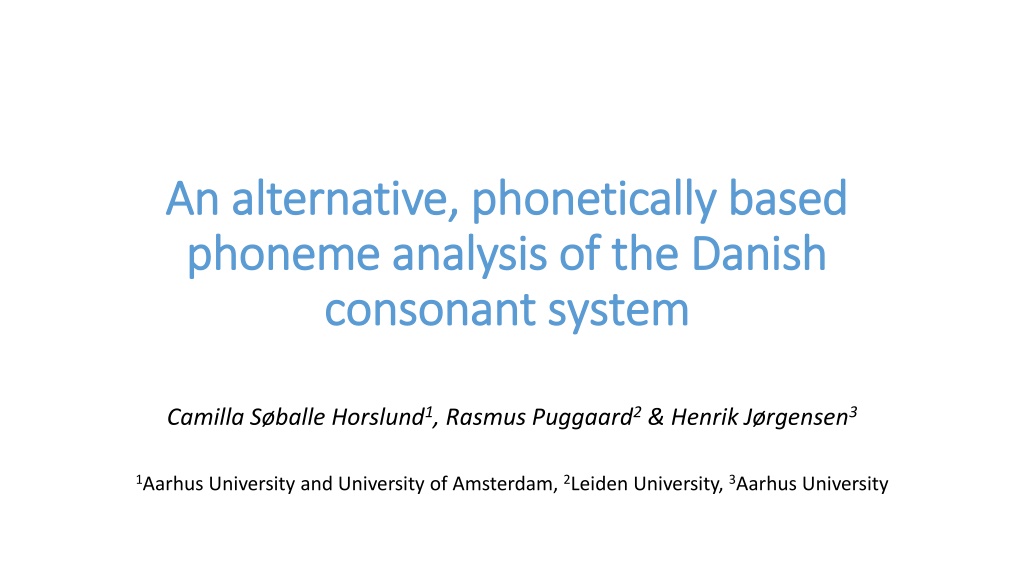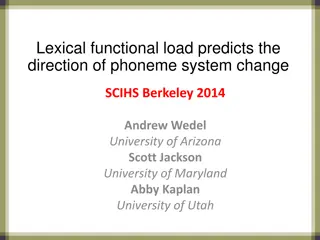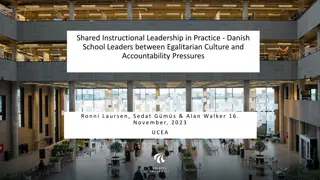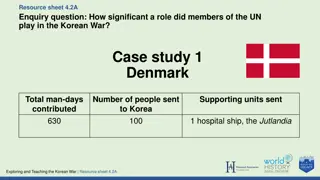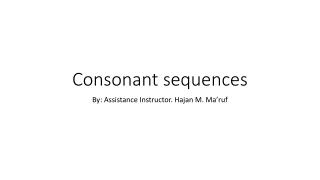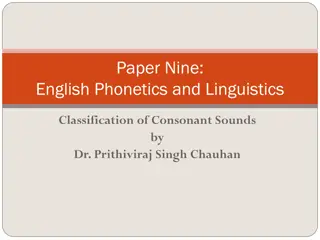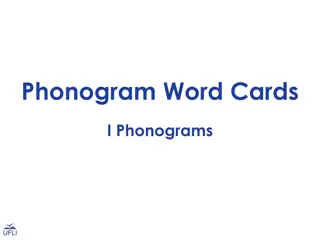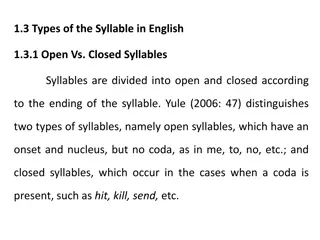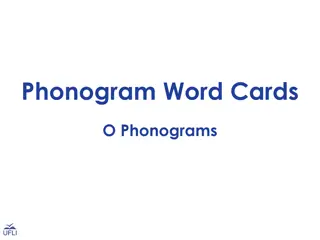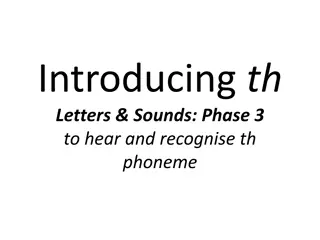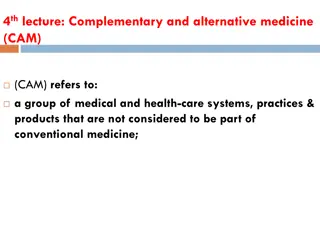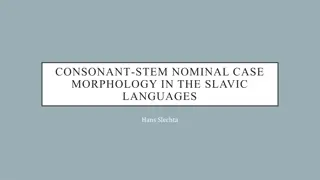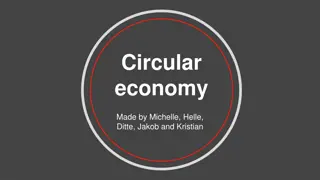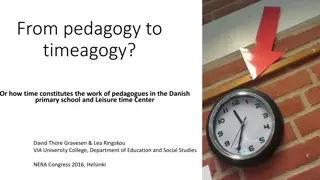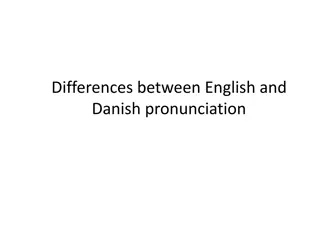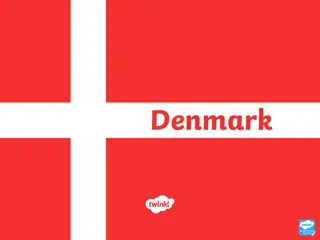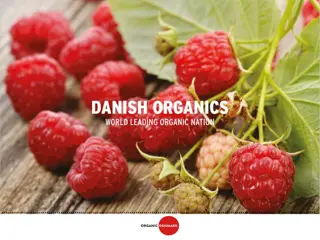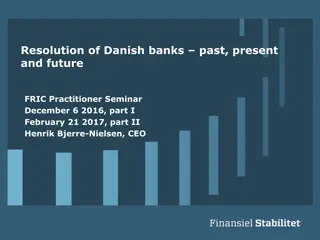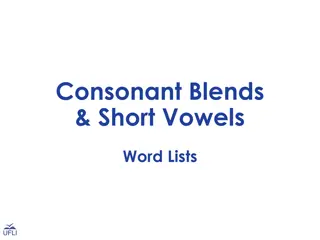An Alternative Phonetically-Based Phoneme Analysis of the Danish Consonant System
This study challenges the standard analysis of the Danish consonant system, proposing a new phonetically-based approach. It critiques the outdated standard analysis that links unaspirated plosives with semivowels, arguing that the alternative analysis is more in line with phonetic facts and easier to learn from language input. The inventory, phonemes, and phonetic realisations of the Danish consonant system are explored, highlighting problematic phones and morphological alternations. The study presents a fresh perspective on Danish phonology, emphasizing the importance of accurate phoneme analysis.
Download Presentation

Please find below an Image/Link to download the presentation.
The content on the website is provided AS IS for your information and personal use only. It may not be sold, licensed, or shared on other websites without obtaining consent from the author. Download presentation by click this link. If you encounter any issues during the download, it is possible that the publisher has removed the file from their server.
E N D
Presentation Transcript
An alternative, phonetically based An alternative, phonetically based phoneme analysis of the Danish phoneme analysis of the Danish consonant system consonant system Camilla S balle Horslund1, Rasmus Puggaard2& Henrik J rgensen3 1Aarhus University and University of Amsterdam, 2Leiden University, 3Aarhus University
A showdown with the standard analysis The standard analysis of the Danish consonant system links the unaspirated plosives [p-, t-, k-] with the semivowels [- , - , - ] as realisations of the phonemes /b, d, / due to alternations like these: /b/ /d/ / / k [ ]e/k [p]e k [p]te (buy - bought) meto[ ]e meto[t]ik (method - methodology) ba[ ]e ba[k]te ba[ ]v rk (bake (inf.), past tense, baked goods) Our argument: The standard analysis is outdated and impossible to learn from the language input an alternative phoneme analysis of the Danish consonant system Based on phonetic facts Possible to learn from the language input
The Danish consonant inventory Labials Alveolars Palatals Dorsals Glottals Labial- dorsals ph- ts- kh- Voiceless aspirated plosives Voiceless unaspirated plosives Voiceless fricatives Central approximants Lateral approximants Semivowels Nasals p t k f s - j- h- - - l - n - - - - m [ph, ts, kh, , h, , j, ] only occur in onset (strong position) [ , , , , ] only occur in coda (weak position) 3
Phonemes and their phonetic realisations Unproblematic phones Problematic phones The link between [ph-, ts-, kh-, p-, t-, k-, -, j-, - ] and [- , - , - , - ] is a central problem in Danish phonology [f-, s-, m-, n-, l-] and [-f, -s, -m, -n, - l] are realisations of /f, s, m, n, l/ respectively The standard analysis has been the most dominant solution to this problem [h-] is the only realisation of the phoneme /h/ The analyses of [- ] and [ -] constitute separate problems, which we won t discuss
The standard analysis Morphological alternations Phoneme Onset realisation Weak realisation Strong realisation [ph]il [ts]yv galo[ph]ere va[ts]ere /p/ /t/ (arrow) (thief) galo[p] (gallop) va[t] (cotton wool) la[k] (laquer) plom[p]e (seal) k [ ]!/k [p]! (buy!) meto[ ]e (method) s [ ] (sweet) ba[ ]! (bake!) ba[ ]v rk (baked goods) fonolo[ ] (phonologist) effekti[ ] (efficient) (to gallop) (to apply cotton wool) (to laquer) (to seal) (past tense) [ph-, -p] [ts-, -t] [kh,-k] /p/ /t/ /k/ [kh]op (cup) [p]il la[kh]ere plom[p]ere k [p]te meto[t]ik (methodology) s [t] (neuter) ba[k]te (past tense) /k/ /b/ (car) /b/ [p-, -p/- ] [t-, - , ] /d/ [k-, - , - , ] / / /d/ [t]ag (day) / / [k]iv! (give!) [ -, - ] [j-,- ] [ -, - , ] /v/ /j/ /r/ fonolo[k]i effekti[ ]isere (phonology) (to make efficient) /v/ [ ]is! (show!) /j/ /r/ [j]ul [ ] d (Christmas) h [ ] (high) (advice) natu[ ] (nature) h [ ]t (neuter) natu[ ]ist (naturist/ nudist) 5
Different versions of the standard analysis Uldall (1936) Phonetically different onset and coda phones can be linked to phonemes through morphological alternations Rischel (1970) /p, t, k/ are always plosives. Aspirated in onset and unaspirated in coda. /d, / are realised as plosives in onset and as fricatives or semi-vowels in other positions The weak realisation of /b/, [ ] was not standard in 1970. Soft g [ ] was the standardised weak realisation of / /, next to the unstandardized [ , ]. Gr nnum (2005) Follows Rischel s analysis and adds two links: [ -, - ] as realisations of /v/ and [ -, - ] as realisations of /r/ Basb ll (2005) 3 levels: morphophonemes phonemes phonetic realisations The plosive alternations are placed in the interface between morphophonemes and phonemes /p, t, k/ only occur in onset while / / only occurs in coda The alternations [ -, - ], [j-,- ] and [ -, - ] are placed in the interface between phonemes and phonetic realisations Phonemes can be deduced from morphophonemes, but the opposite is not possible
Overview Overview over the 3 analyses 3 analyses over the [ph-, -p] [ts-, -t] [kh,-k] /p/ /t/ /k/ /b/ [p-, -p/- ] [t-, - , ] /d/ [k-, - , - , ] / / /v/ /j/ [ -, - ] [j-,- ] [ -, - , ] /r/ 7
Problems with the standard analysis 1. Neutralisations that cannot be dissolved 2. Lack of shared phonetic properties between different allophones of the same phoneme 3. Limited and problematic morphophonological evidence The proposed system cannot be learned from the input
1. Neutralisations that cannot be dissolved A coda [ ] can represent 2 different phonemes or morphophonemes / , j/ A coda[ ] can represent 3 different phonemes or morphophonemes /b, , v/ [ ] and [ ] can represent the same abstract category / / Dissolution ( through alternations and vowel conditioning) are not possible for most words: [ ] in kage (cake), mage (mate), lige (equal) can represent either / / or /j/ [ ] in lov (law), krage (crow), krave (collar) can represent either / / or /v/ A central problem for a phoneme analysis It is a widespread assumption that speakers store phonemic forms in their lexicon (see e.g. Hayes 2009; Gussenhoven & Jacobs 2017) A problem for language acquisition
Understanding the problem: Natural phonology Terminology The standard analysis Uniformity 9 out of the 12 oral consonants have more than one realisation Most consonants have 1 strong and 1 weak realisation /r/ has 1 strong and 2 weak realisations [ , ] / / has 1 strong and 3 weak realisations [ , , ] Uniformity Max uniform: Only 1 phonetic realisation of each phoneme The more realisations, the lower the uniformity Transparency Max transparent: Each phone represents a single phoneme The more phonemes a phone can represent, the lower the transparency Transparency Coda [ ] has 2 different sources/ , j/ Coda [ ] has 3 different sources /b, , v/ Biuniqueness Simultaneous uniformity and transparency A 1-to-1 relationship between phones and phonemes Biuniqueness Only /f, s, m, n, l, h/ have a biunique relation between phones and phonemes 10 (See cs et al. 2008 and Gal as 2001)
The acquisition problem: The BiPhon model A bidirectional model of phonetics and phonology (e.g. Boersma 2011): Grammar with 5 levels Comprehension and production make use of the same grammar The child learns pairs of [phonetic form] and meaning and must construct all intermediary levels meaning <morphemes> |underlying phonological form| Computer simulation study of French liaison (Boersma & Leuwen 2017): /phonological surface form/ Most virtual learners established suppletive forms for masculine and feminine conjugations of the adjective bon (good) in order to generate the two phonetic forms [b ] and [b n] We expect virtual learners of Danish to establish suppletive forms of the verb stem of bage (bake) in order to generate the three phonetic forms [p ], [p k] and [p ] [phonetic form] (from Boersma & Leuwen 2017) 11
2. Lack of shared phonetic properties between different allophones of the same phoneme A result of 2 sound changes: 1. Loss of voicing in /b, d, / before the 1700s (Brink & Lund 2018) The step from voiceless plosives to semi-vowels becomes very long 2. Loss of soft g [ ] for people born after approx. 1920 (Brink & Lund 2018) lack of phonetic link between onset [k] and coda [ , ] It is possible during language change that two allophones drift too far apart to count anymore as variants of the same basic linguistic unit (Hayes 2009)
3. Limited and problematic morphophonological evidence Evidence from alternations in: Irregular verbs of the -te type, e.g. ba[ ]e ba[k]te Loanwords of Greaco-latinate origin, e.g. fonolo[ ] fonolo[k]i (bake (inf.), past tense) (phonologist phonology) Evidence suggests that these are learned too late to play a role in phonological acquisition: 75% of Danish children have acquired all consonant allophones by the age of 5.5 years (Heger 1979 ) A more recent study by Clausen & Fox-Boyer (2017) show even earlier acquisition Irregular verbs of the -te type is not fully mastered at the age of 8 years (Bleses 2000) It is implausible that: /b, d, /-categories are built on alternations such as hydrofo[p] hydrofo[p]i, fonolo[ ] fonolo[k]i, abbe[- ] abbe[t]isse /p, t, k/- categories are built on alternations such as mikrosko[p] mikrosko[ph]i, demokra[t] demokra[ts]i, patriar[k] patriar[kh]at
A phonetically based alternative analysis We are not primarily interested in making all possible structural ( significant ) generalizations about phonology ( ) Instead, we are interested in those generalizations that a speaker-listener may reasonably make. (Linell 1975) Inspiration: cs & J rgensen (2016) A different set of phonemes in onset and coda Same phoneme analysis as Basb ll (2005) but with suppletive roots where Basb ll has morphophonemes Completely biunique, uniform and transparent Our analysis Same set of phonemes in onset and coda /b, / only occurs in onset as [p, k] [ ] and [ ] are considered realisations of the phonemes whose onset realisation they most closely match, i.e. /j/ and /v/. In cases which show clear alternations, we propose suppletive roots. Biunique from a positional perspective
Overview Overview over the two two phonetically phonetically based based analyses analyses over the 15
The phonetic basis for our analysis Phoneme Onset Coda Shared phonetic properties Proposed coda lenition /p/ /t/ /k/ /b/ [p ] [ts] [k ] [p] [p] [t] [k] - Voiceless bilabial plosives Voiceless alveolar plosives Voiceless velar plosives - Aspiration loss Aspiration loss Aspiration loss Defectively distributed /d/ / / /v/ [t] [k] [ ] [ ] - [ ] Alveolar oral consonants - Labial voiced oral continuants Vocalisation Defectively distributed Vocalisation /j/ [j] [ ] Palatal voiced oral continuants Vocalisation /r/ [ ] [ ] Pharyngeal voiced oral continuants Vocalisation Suppletive forms account for alternations such as: k [ ]e/k [p]e k [p]te ba[ ]e ba[k]te ba[ ]v rk (buy - bought) (bake (inf.), past tense, baked goods) 16
Conclusion The consonant system we propose is contrary to the one proposed by the standard analysis possible to learn from the language input because: 1. The system is biunique from a positional perspective there is no neutralisation problem 2. The phonetic realisations of the same allophone share at least one phonetic property the connection between them can be perceived in the input 3. The analysis does not require children to build their phonetic system on the basis of alternations in irregular verbs and loanwords they are unlikely to learn in early childhood Since we propose less phonemes than cs & J rgensen, our system is more economical, all things considered
[ [m m t ts s k k] ] [ [ k k ju ju ] ] Questions and comments 18
References cs, P ter, Katalin Fenyvesi & Henrik J rgensen. 2008. Dansk fonologi or morfologi set i lyset af de s kaldte naturlighedsteorier. NyS Nydanske Sprogstudier 36: 10-37. cs, P ter & Henrik J rgensen. 2016. Hvorfor er dansk vanskeligt? Danske konsonantsegmenters to ansigter. Skandinavisztikaj F zetek 10: 89-100. Basb ll, Hans (2005). The phonology of Danish. Oxford: Oxford University Press. Boersma, Paul. 2011. A programme for bidirectional phonology and phonetics and their acquisition and evolution. In Anton Benz & Jason Mattausch (Eds.), Bidirectional Optimality Theory, 33 72. Amsterdam: John Benjamins. Boersma, Paul & Jan-Willem Leussen. 2017. Efficient evaluation and learning in multilevel parallel constraint grammars. Linguistic Inquiry 48(3): 349-388. Bleses, Dorthe. 2000. Transparens og produktivitet i danske b rns tilegnelse af verbers pr teritum. Nydanske Studier & Almen Kommunikationsteori 26+27: 165-196. Brink, Lars & J rn Lund. 2018. Yngre nydansk. In Ebba Hjort, Henrik Galberg Jacobsen, Bent J rgensen, Birgitte Jacobsen, Merete Korvenius J rgensen & Laurids Kristian Fahl (Eds.) Dansk Sproghistorie 2: Ord for Ord, 197-228. Aarhus: Aarhus Universitetsforlag. Clausen, Marit Carolin & Annette Fox-Boyer. Phonological development of Danish-speaking children: A normative cross-sectional study. Clinical Linguistics & Phonetics 31(6): 440 458 Gal as, Grazia Crocco. 2001. Uniformity, Transparency of Encoding, and Bi-Uniqueness within the Model of Natural Morphology. SILTA (Studi Italiani di Linguistica Teorica ed Applicata) XXX/2: 397-405. Gr nnum, Nina. 2005. Fonetik og fonologi. Almen og dansk. Copenhagen: Akademisk forlag. 3rd edition. Gussenhoven, Carlos & Haike Jacobs. 2017. Understanding Phonology. Oxon and New York: Roudtledge. 4thedition. Hayes, Bruce. 2009. Introductory Phonology. Malden, Massachusetts, Oxford and West Sussex: Wiley-Blackwell Linell, Per. 1975. Psychological reality in phonology. Cambridge University Press. Rischel, J rgen. 1970. Consonant gradation: A problem in Danish phonolgy and morphology. In Benediktsson (Ed.), The Nordic Languages and Modern Linguistics, 460-480. Reykjav k: V sindaf lag slendinga. 19
